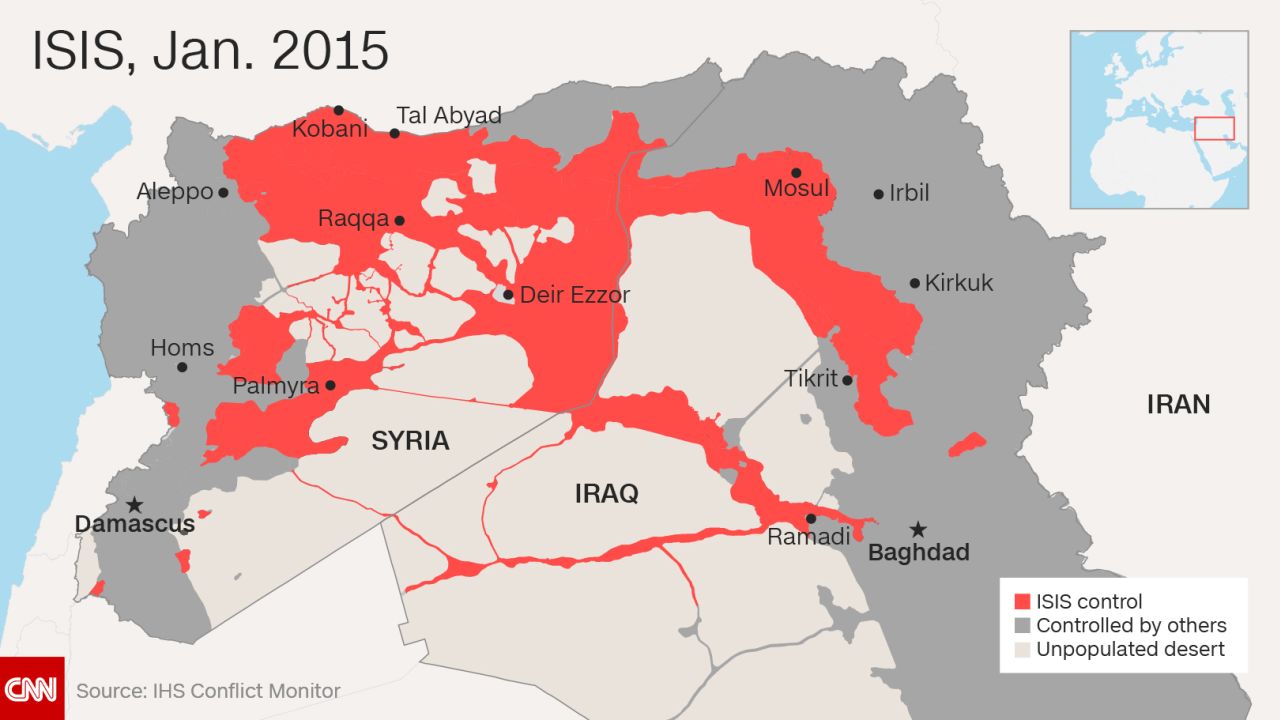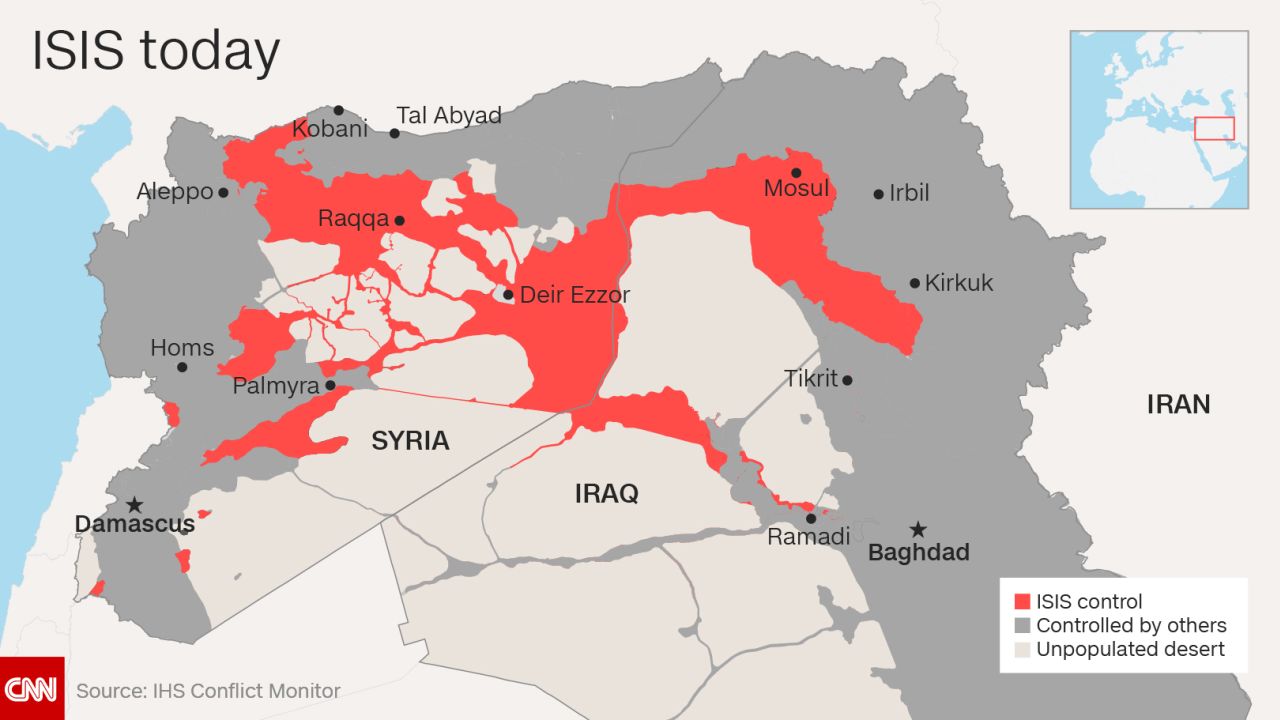Story highlights
Despite losing territory ISIS continues to demonstrate resilience and versatility, writes Tim Lister
Analysts are expecting an increase in mass casualty attacks as the 'caliphate' shrinks
The last few days have seen both the vulnerability and the resilience of ISIS as it struggles to hold on to territory in Syria and Iraq. But a new analysis of the battlefield shows that territory held by ISIS has shrunk 12% this year, with losses in both western Iraq and northern Syria.
Over the weekend, Iraqi forces regained control of Al-Qayyarah air-base, 75 kilometers (about 50 miles) south of the city of Mosul. ISIS seized the base two years ago when its fighters swept south to the edge of Baghdad.
If Iraq’s military can consolidate control of the base, it would provide a valuable launching pad for the offensive to expel ISIS from Mosul. Al-Qayyarah is one of the largest airbases in Iraq.
But ISIS continues to demonstrate resilience and versatility. Its fighters are clinging on to positions inside the Syrian town of Manbij, a critical waypoint between Raqqa – the group’s administrative headquarters – and the Turkish border.
Further south, it shot down a Russian helicopter near Palmyra, even though it lost control of the city in March.
The new IHS Conflict Monitor map shows that ISIS controls roughly 68,300 square kilometers (26,370 square miles) of Iraq and Syria – about the size of the Republic of Ireland. That compares to 78,000 square kilometers (30,116 square miles) at the beginning of the year.
Its main losses have been in Iraq’s western Anbar province, including the city of Fallujah, and in northern Syria, where both the regime of President Bashar al-Assad and a rebel alliance of Kurds and Arab factions are closing in on Raqqa.
International reach
IHS senior analyst Columb Strack says that “as the Islamic State’s caliphate shrinks and it becomes increasingly clear that its governance project is failing, the group is re-prioritizing insurgency.”
He told CNN: “As a result, we unfortunately expect an increase in mass casualty attacks and sabotage of economic infrastructure, across Iraq and Syria, and further afield, including Europe.”
In other words, ISIS is going to become a more ‘traditional’ terror group, boasting of its international reach to attract recruits and bolster morale as it loses ground in Iraq and Syria.
According to IHS and other analysts, revenues for ISIS also continue to shrink, making it more difficult to finance its self –styled caliphate. IHS estimates that a year ago its monthly revenue was about $80 million; now it is probably less than $40 million. That will likely affect the internal cohesion of the group.
“Over the coming year we are likely to see more towns and cities become isolated from the core caliphate, as was the case in Ramadi and Fallujah.” Strack says. “This could enable the fragmentation and gradual defeat of the Islamic State as a conventional force.”
Pincer movement
While previous losses have mostly been at the fringes of ISIS-held land, larger pockets are now surrounded and isolated, such as Hawija and surrounding areas south of Tikrit in Iraq.
The retaking of Al-Qayyarah airbase also brings one step closer the liberation of Mosul – the symbol of the caliphate. On a visit to Iraq Monday, U.S. Defense Secretary Ash Carter said the base would become a “logistics hub” with U.S. units “prepared to advise and accompany [ISF] to the battalion level.” It would make an obvious base for long-range artillery support.
Carter says he envisages “the envelopment of Mosul… in a pincer between a movement from the south by Iraq Security Forces, and a movement from the north by [Kurdish] Peshmerga forces.
Strack said Al-Qayyarah was a U.S. ‘super base’ during the 2003–11 occupation, with a runway capable of supporting C-5 cargo aircraft, and a 20-kilometer security perimeter.
Strack believes setbacks to ISIS in northern Syria are even more critical.
“The likely capture of Manbij by the U.S.-backed Syrian Democratic Forces (SDF) would have a major impact on the Islamic State’s ability to supply Raqqa, and by extension the remainder of its territory, with new recruits and supplies.”
He said ISIS is “throwing everything they have at Manbij to maintain access to the Turkish border,” which is more important to ISIS’ survival as a ‘state’ than Fallujah or even Mosul.
“Ultimately, foreign fighters and senior commanders are likely to move to northern Syria” from Iraq, Strack told CNN. “Mosul of course has great symbolic importance, but strategically it is very much secondary to Raqqa,” he said.
Exploiting crossings
“The Islamic State probably calculates that it can return to Anbar province and Mosul with relative ease in the future, sacrificing governance there temporarily to defend the core caliphate in Syria.”
Another pressure point is Deir al-Zour in northern Syria, a vital hub for ISIS as it tries to keep lines of communication open between its territory in Iraq and Syria. Most of the city is in the hands of ISIS’ but a Syrian army garrison occupies the military airport.
“If Syrian government forces manage to push east from Palmyra and link up with the surrounded garrison in Deir al-Zour, that would sever the Islamic State’s logistical backbone along the Euphrates, separating Raqqa from the oilfields of eastern Syria, and from Iraq,” Strack told CNN.
But the Syrian army is over-stretched as it continues to squeeze Aleppo and defend regime heartlands on the coast. An advance on Tabqa – west of Raqqa – was repulsed by ISIS three weeks ago. Any move to break the siege of Deir al-Zour looks months away, with the Syrian army still heavily reliant on Russian air support and militia from Iran and Iraq to make battlefield gains.
ISIS still has other factors in its favor. As an organization it is decentralized, with its province (or willaya) structure “probably enabling it to retain control in parts of the caliphate even if these become isolated,” says Strack.
For now it can continue to exploit informal crossings into Turkey along an approximately 90 kilometer (60 miles) stretch of the border it still controls. And the complex battlefield in this part of Syria may help ISIS retain some routes from Raqqa.
Some analysts also expect ISIS may be able to exploit rivalries such as that between the Kurdish militia and some Arab tribes in northern Syria; and Shia and Sunni factions in Iraq.
Most of the battlefield gains against ISIS in Syria have been made by the Kurdish YPG, the largest group in an uneasy alliance with several Arab rebel groups. But the gains have taken the Kurds deep into what is traditionally Arab land.
“Local ethnic tension will make it easy for the Islamic State to find recruits among disaffected residents looking for ways to assert Arab control over Arab areas,” writes Middle East analyst Asher Berman, especially as it mutates into a “networked terrorist group.”
ISIS is trying to aggravate similar tensions through its bombing of Shia neighborhoods in Baghdad, and if anything will step up such attacks following the devastating suicide bombing in the Iraqi capital at the beginning of July.
U.S. Defense Secretary Ash Carter told reporters that while defeating ISIS in Iraq and Syria is “necessary” it is “not sufficient.” While there’s been steady progress in shrinking what Carter calls the “parent tumor,” there is growing concern over the metastasis of ISIS terrorism far beyond Iraq and Syria.









